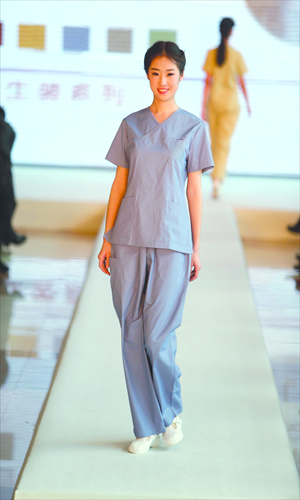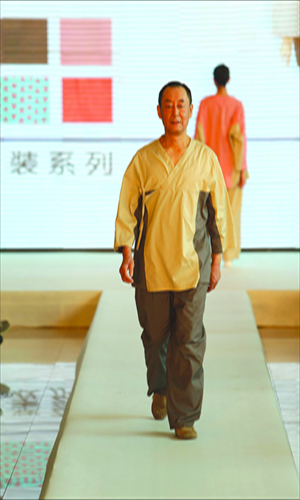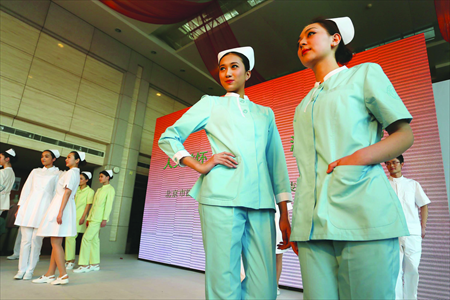Hospital gowns get makeovers




Beijing hospital clothing is breaking out of its prison. The old blue and white striped gowns are out, and in fashion are yellow smocks for gents, pink for ladies. Well, at least that's the hope for the newly launched redesign of medical uniforms making their way into Beijing's 21 hospitals since the start of April.
"People were saying that the old design of blue and white lines looked like prisoner's uniforms," said Yu Zhen, director of the basic operation department of the Beijing Municipal Administration of Hospitals, the sponsor of the endeavor. "We wanted to reduce the notion of the patient as a sick person in hospitals by introducing gentle, light colors on their gowns that make them feel at home."
Yu said that the color is one major focus they wanted to put into the new design.
"Given that color can impact mood, we adopted a pale yellow color for men and pale pink color for women," he said.
Pale yellow is a gender-neutral color that was selected because it alleviate negative feelings. Pale pink was chosen because it is a pleasant color for females, according to the a brochure created by the designer.
The design was made to match the patients' uniforms with the medical staff. For instance, the patients of the obstetrics department wear pink, and doctors wear a complementary red color, said Yu.
"Clothes with the same color intensity are able to match each other," he said, noting this narrows the gap between patients and medical staff.
Colors weren't the only concern. Function played a significant role in the redesign.
"For instance, the two pockets on both sides of the garment have holes that allow access to medical tubes without having to take the patient's clothing off," he said.
Patients from different types of wards will find that their gowns are very practical. Patients with leg injuries will find that they do not need to roll up their trousers or take them off for a doctor's inspection. The new garments have zippers on either side of the trouser legs for easy inspection.
The new mother's gown also shows smart new functionality. Women who have just given birth will have a dress with a collar overlapping with two large pieces. When the patient needs to breast-feed her baby, she will take off the button that holds the two pieces together and lift one of the pieces up to feed the baby discreetly.
Off the rack
This uniform redesign has been in the works since the end of 2011. It started with a nationwide bid invitation, with six firms winning out, and then moved on to a call for design concepts.
Yu said they wanted a fresh new style to replace the old-fashioned hospital wares.
The winner from this competition is Beijing native Shen Zedan.
"Actually, she appealed to us exactly because of her little experience in it," he said.
In 1999 and 2004 Shen won China Fashion Week awards, for designing men's clothes.
In order to get feedback about the new designs, Shen invited presidents, doctors and nurses of hospitals to try the clothing on and share their opinions of the new look.
"We didn't ask patients to try the new uniforms, though," Yu said. Instead, the designer asked her family members to try them.
Shen said that there might be traditional Chinese elements involved in the design of the new clothes, but added that you could also find many of the same elements in similar Western attire. For instance, the V-shape collar gown and the rope that fasten the cloth is for the convenience of medical tests.
Unlike the old outfits, which were 100 percent cotton, the new ones are 30 percent polyester, which makes them more wrinkle resistant and long-lasting.
Summer season collection
The redesigned garments have not yet made it to most of the 200,000 patients and 50,000 medics in the Beijing system. When a Metropolitan reporter went to Chaoyang Hospital on April 11, one of the five hospitals where the new designs have been dispatched, only a few patients were dressed in the new garments. After a stroll in wards, most of the patients and all of the children were seen still in the old gowns of blue and white colors.
Some of the patients who tried the new garments grumbled to Metropolitan about the new outfits. One patient surnamed Yan said that he does not love his new clothes, claiming they look clumsy and are not as warm as the old ones.
"It is not full-sleeved nor is it 100 percent cotton," he said. "Besides, the overlapped collars cannot fully cover my chest, when it is drafty."
Another patient surnamed Zhang said that he wonders if corresponding health authorities ever consulted patients for advice on the new design.
"If the dress does not look good, it should at least be made with comfortable material," he said, complaining noting that the cotton-polyester blended fabric is not comfortable.
As these designs have been slowly reaching patients - starting with five hospitals this month before being introduced to the entire system in May - some Web users also expressed their opinions about the new garments.
Weibo users posted snapshots of the new outfits in early April. Although some applauded the new changes, many condemned its color, style and fabric.
"The new clothing has no passion at all. Its look is rather like that of a beggar," wrote Niaolanfeifei, a Weibo user.
Another Weibo microblogger named Daisy Mengmeng commented that she felt that in the new garments, the patients' conditions could worsen.
"Patient gowns are a kind of fashion that require beauty and comfort just like any other garment," she wrote.
On the positive side, Aliweng said, "I do not want to get sick after looking at the new design."
One size does not fit all
When Metropolitan reached Shen for a comment about the public disapproval for her designs, she said that one reason people are unhappy is that the patients haven't been given appropriately-sized gowns. She said that hospitals tend to give people a larger size because it makes removing or putting on the clothes easier.
There are also a few tweaks that will be made to the design after its full launch next month, she said.
To Shen, different people were bound to have different takes on the redesign.
"Therefore, it's hard to tell who is right and wrong from an aesthetic perspective," she said.
Hospital authorities have already received public feedback and say they are ready to take corrective action when necessary.
Yu also revealed that another factor must be considered for any changes to the designs - cost.
"The expenditure of this new change in clothing in hospitals is partially covered by the municipal government and the rest of the expenses fall on the shoulders of the hospitals themselves," said Yu. "Making huge changes [to this new design] would be a financial burden to the hospitals." The color of the newly designed clothes could be changed if people don't like them, but the style is fixed.
"We would like to make some changes to the patient gowns or medical uniforms in light of the feedback pouring in this month," Yu said. "A design will never make everyone happy, though."
Meanwhile, we can all hope that the clever use of color and design in the new uniforms will lead to patients having a more pleasant and convenient stay while they are in the hospital, no longer feeling like they are prisoners of their illness.